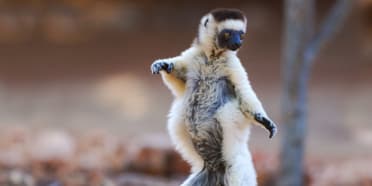- You are here:
- Home
- Countries & Parks
- Madagascar Parks
- Berenty Private Reserve
- Reviews
- Expert Reviews
Expert Reviews – Berenty Reserve

Anthony is a photographer and writer for travel magazines and Lonely Planet, including the guides to Kenya and Botswana & Namibia.
Ring-tailed lemurs and tamarind forests
Berenty is a funny place. It has long been known as an important ecotourism destination, largely because it was one of the first of its kind in Madagascar. The BBC has filmed here on a number of occasions. It is rightly famed as one of the best places in the country to see ring-tailed lemurs. This is one of the few places in the country that they are habituated and less afraid of people. The tamarind gallery forest that dominates much of Berenty is something of a rarity these days, and the Mandrare River has some pretty corners. However, Berenty is a long way from anywhere. The wildlife viewing is just as good, probably even better, in some of the other parks of the south. My overall impression is of a once-important reserve whose appeal has been surpassed by other, more accessible reserves across the country.

Dale is a multi-award-winning writer and photographer with more than 500 published magazine articles featured in magazines such as National Geographic, BBC Wildlife, Travel Africa, and CNN Travel.
Dancing Sifakas & Ragged Ringtails
Berenty is a very small wildlife reserve set in a monoculture sea of spiny sisal plantations.
It is only about 2.5km2 in size but incorporates a lovely patch of evergreen gallery forest alongside the Mandrare River. The small island-like nature of this reserve means that the wildlife is very constrained and therefore easy to see.
You will find friendly, habituated troops of brown and ring-tailed lemurs as they go about their business socializing and foraging for food. During the heat of the afternoon, it’s not unusual to find them lounging around on your patio beneath the shade of your awning. Leave a door open by accident, and you are likely to find a troop of lemurs rummaging through your luggage and toiletries.
Berenty is also famous for its ‘dancing’ Verreaux’s sifaka. Watching them leap like ballet dancers down the reserve’s sandy roads is a highlight.
Sadly, during the dry season (July to September) food can become scarce in the forests, and some of the primates have taken to eating an invasive plant that causes their hair to become patchy. As such, they can end up looking a little like irradiated gremlins.
There’s also an option to drive to some nearby spiny forest fragments for both day and nighttime guided walks. There, you will see nocturnal animals such as the tiny mouse lemur and wide-eyed sportive lemurs as they leap between the thorny branches of strange, otherworldly ‘octopus’ trees.

Philip is an acclaimed travel writer and author of many guidebooks, including the Bradt guides to Uganda, Tanzania, Kenya and South Africa.
A contrived ‘spiny forest’ primer
The world-famous Berenty Private Reserve is the main tourist focus in the Mandrare River Valley, a region which is now dominated by sisal plantations but still remains home to small pockets of spiny forest and forms the main stronghold of the bizarre multi-tendrilled octopus-tree Didierea madagascariensis. Only 2km2 in extent, the sanctuary protects the one last stand of natural vegetation within a 60-sq-km sisal estate still owned by the same family that founded it in 1936. To me, Berenty felt more like an open-air zoo than a genuine eco-destination. Indeed, despite offering a great opportunity to see and photograph ring-tailed lemurs and ‘dancing’ Verreaux’s sifaka, I far preferred the nearby Mandrare River Lodge. The lodge works in conjunction with local communities to offer guests a range of guided activities in stands of spiny forest and riverine woodland protected by ancient fady or modern consensus as part of a patchwork community reserve. Both places offer a good opportunity to see endemic dry-country birds such as giant coua, running coua, subdesert brush-warbler and thamnornis-warbler.

Ariadne is a renowned African wildlife photographer whose work is featured in many well-known guidebooks and magazines.
An oasis for ring-tailed lemurs and Verreaux’s sifakas
To me, the small 2km²/0.8mi2 private sanctuary, set in the middle of a large sisal plantation, is somehow lacking in wilderness appeal. It is, however, a great place to photograph and get close to two very charismatic lemur species: Verreaux’s sifaka and ring-tailed lemur. The latter are particularly habituated and there is a permanent presence of them around the lodge. I was delighted seeing them all sunbathing with their arms stretched out on the lawn at breakfast. Even more special is the chance to see the Verreaux’s sifakas perform their dancing terrestrial motion for which they are famous. The trick is to catch them as they cross the property daily from the spiny forest where they feed, to the riverine forest where they sleep, and vice versa.
The mid-range lodge is very popular with package tourists and it can get a bit crowded, but as you are allowed to move around the property unguided, it’s always possible to find a quiet corner and have a special private encounter with the diurnal lemurs. To see nocturnal species, such as mouse and sportive lemurs, you can join a guided night walk in a patch of spiny forest.


 Madagascar Parks
Madagascar Parks